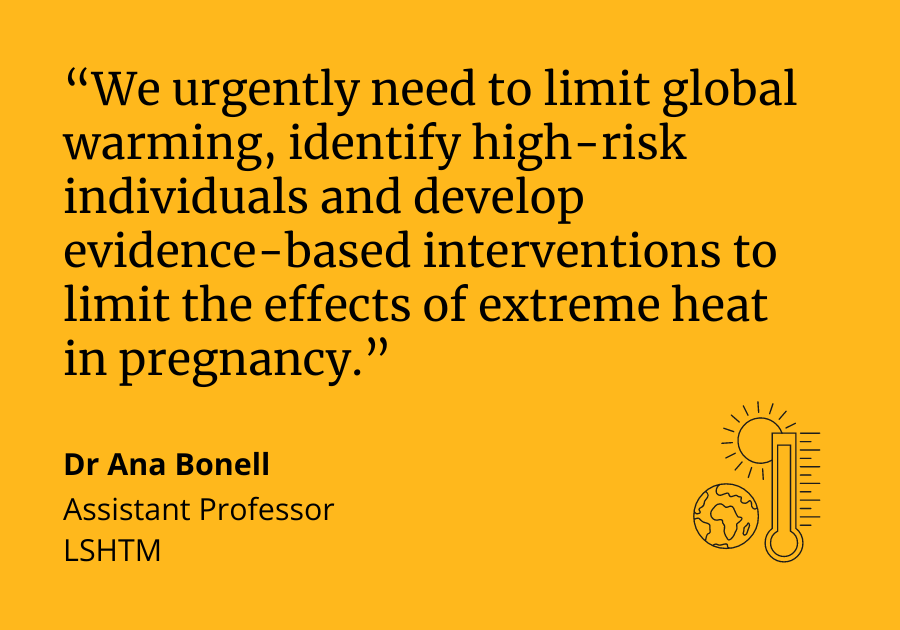
Environmental heat exposure is associated with a greater risk of stillbirth in populations around the world, suggests a new expert review of the current evidence.
In total, 19 out of 20 studies included in this review found an association between stillbirth risk and heat.
According to the research team, led by the London School of Hygiene & Tropical Medicine (LSHTM), this review demonstrates that there is now clear evidence from both tropical and temperate regions on the impact of acute and chronic heat exposure on the risk of stillbirth.
They suggest that more research is needed to understand the complex interplay between confounding risk factors of stillbirths, such as socio-economic status or chronic health conditions, in order to develop and implement interventions against the effects of heat, in the face of climate change.
The findings are published in BJOG: An International Journal of Obstetrics and Gynaecology.
Stillbirths1 occur in high numbers globally, yet they are often overlooked, and actions to reduce them are not included in many national healthcare plans. In addition to cumulative risk factors including access to antenatal care, socioeconomic status, and pregnancy history, environmental factors such as heat can also increase the risk of stillbirth. Although previous reviews of the literature around high temperatures and stillbirth risk exist, there was a lack of evidence at the time they were conducted from lower- and middle-income countries.
In this article, authors reviewed 20 studies examining the association between heat exposure and stillbirth in countries around the world, including some more recent studies from Africa and Asia. They found that 19 of these studies demonstrated an association between stillbirth risk and both long-term and short-term heat exposure. Though there is variation in methods and measurements used, the review indicates that populations are at an increased risk of stillbirth when they are exposed to temperatures above 90% of the normal temperature range for that location.
During pregnancy, changes occur in the body that affect its ability to regulate temperature, and potentially increase the risk of an overall increase in body temperature. The challenge to maintain a steady temperature is just one of many factors that could cause stillbirth during exposure to heat. Despite the known physiological and environmental risk factors causing stillbirths, an estimated 30% of cases have no clear cause. This review highlights that detailed studies of the heat-health effects on pregnancy in humans are lacking, and it is likely that there are many interacting factors involved, both biological and environmental.
The current public health action to protect against heat exposure is also reviewed by the authors, and while there is no pregnancy-specific guidance on reducing the impacts of heat on stillbirths, methods to reduce the heat health risk in pregnancy more generally are evaluated, as these actions could help to avoid all adverse birth outcomes. Pregnant women are included as vulnerable members of society in international and national guidance on prevention and treatment of heat stress, however this study calls for an increased awareness of heat risks among healthcare workers and clinicians. Authors suggest that pregnant women experiencing additional risk factors such as socio-economic constraints that limit heat avoidance, or those with chronic health conditions, should receive specific advice or referral to high-risk clinics.
In addition to improving targeted guidance, this article highlights key gaps in the evidence base that maternal health communities must focus their research efforts on, particularly in areas most at risk of extreme heat exposure. The authors stress three main priorities: to reduce extreme heat exposure and the health impacts of climate change by accelerating action to limit global warming; to increase access to sustainable cooling solutions; and to consider the complex social, economic and spatial inequalities affecting those at risk from stillbirth when developing education and intervention strategies.
Dr Ana Bonell, Assistant Professor in climate change, maternal health and occupational heat stress at The MRC Unit the Gambia, LSHTM, and lead author of this study, said “Stillbirths remain a terrible tragedy for families, communities and society. Unfortunately progress in maternal health and birth outcomes are increasingly threatened by the impacts of climate change. We urgently need to limit global warming, identify high-risk individuals and develop evidence-based interventions to limit the effects of extreme heat in pregnancy.”
Publication
Bonell, A., Part, C., Okomo, U. et al. An expert review of environmental heat exposure and stillbirth in the face of climate change: Clinical implications and priority issues. BJOG: An International Journal of Obstetrics and Gynaecology. 2023; 00: 1–9. DOI: 10.1111/1471-0528.17622
1 The World Health Organization defines stillbirth as fetal death after 28 weeks gestation but before or during birth.
Our postgraduate taught courses provide health practitioners, clinicians, policy-makers, scientists and recent graduates with a world-class qualification in public and global health.
If you are coming to LSHTM to study a distance learning programme (PG Cert, PG Dip, MSc or individual modules) starting in 2024, you may be eligible for a 5% discount on your tuition fees.
These fee reduction schemes are available for a limited time only.
